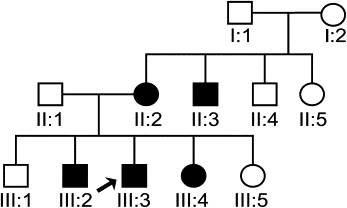Introduction
Primary failure of eruption (PFE) is characterized by nonsyndromic eruption failure of permanent teeth in the absence of mechanical obstruction. Recent studies support that this dental phenotype is inherited and that mutations in PTH1R genes explain several familial cases of PFE. The objective of our study was to investigate how genetic analysis can be used with clinical diagnostic information for improved orthodontic management of PFE.
Methods
We evaluated a family (n = 12) that segregated an autosomal dominant form of PFE with 5 affected and 7 unaffected persons. Nine available family members (5 male, 4 female) were enrolled and subsequently characterized clinically and genetically.
Results
In this family, PFE segregated with a novel mutation in the PTH1R gene. A heterozygous c.1353-1 G > A sequence alteration caused a putative splice-site mutation and skipping of exon 15 that segregated with the PFE phenotype in all affected family members.
Conclusions
A PTH1R mutation is strongly associated with failure of orthodontically assisted eruption or tooth movement and should therefore alert clinicians to treat PFE and ankylosed teeth with similar caution—ie, avoid orthodontic treatment with a continuous archwire.
Editor’s summary
If the next patient you examine has a malocclusion characterized by the unilateral infraocclusion of several posterior teeth with normal vertical facial growth, you might well assume that it will be a long day. The etiology could be a unilateral posterior tongue thrust or even a severe lack of space on the affected side; in other words, it could be a mechanical problem. But if it’s not mechanical, you might consider PFE as the cause. Proving it has long been frustrating, but this research study from the University of North Carolina might change some minds.
The aim of the study was to investigate how genetic analysis can be used with clinical diagnostic information for better orthodontic management of PFE in affected families. Enrollment for this study was based on PFE in at least 2 family members. Through detailed interviews, a pedigree was extended in a family, including 12 people from 11 to 72 years of age. Five male and 4 female subjects were available for clinical and molecular testing. Read the entire article to learn more about the sequencing and mutational analysis of the PTH1R gene. The pedigree and clinical findings further confirm that PFE is an inherited disorder, and that the inheritance can be autosomal dominant with variable expressivity. Noted the authors, “Future research should address these questions: what is the specific role of PTH1R in the spectrum of eruption failure phenotypes, and are additional genes responsible for familial eruption failure?”
Most likely, all clinicians will eventually benefit from such findings when determining the best approach in planning treatment for a patient with PFE. This study is of clinical and genetic interest. Future studies are needed to improve our understanding of the genetic etiology of PFE because this can aid in differential diagnosis, allow early identification of affected family members, and eventually lead to new treatment modalities.





